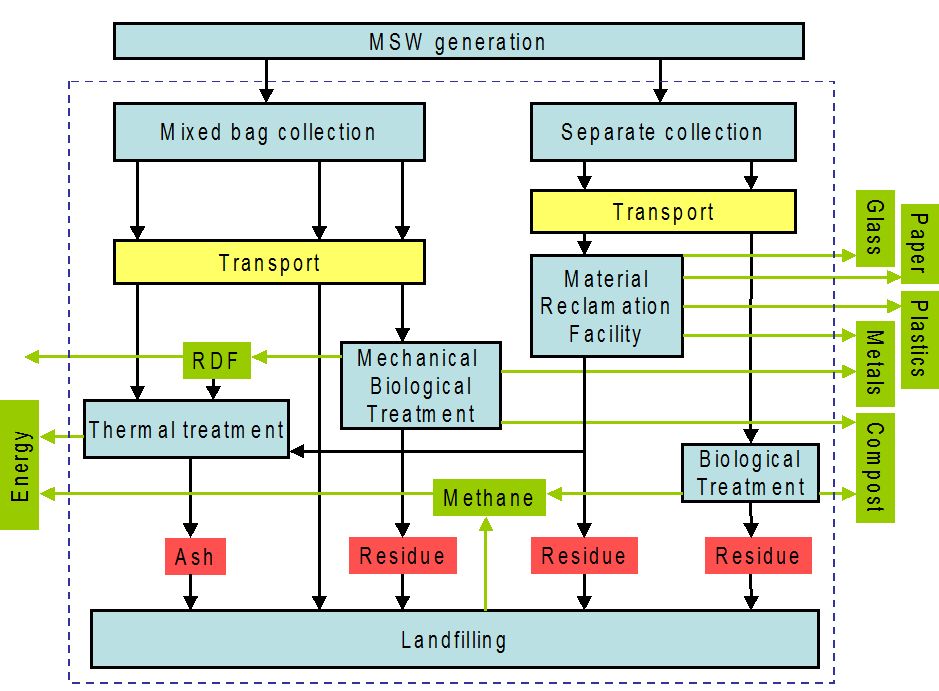
The 1990s were marked in a contradictory way by the expansion of private firms to the detriment of public management, by the pursuit of consolidation and by mistakes in the course of several of the leaders.
The combination of all these forces explains the considerable transformation of supply and hierarchies. It is a situation very different from that of continental Europe where, starting from local monopolies, we have become accustomed to a certain stability of the landscape even if then the fixed points which are the large historical groups are transformed by the interplay of Mergers and Acquisitions.
In the United States, the movements are much faster. As in the new economy, hierarchies can be reversed in a very short time; the new entrant can buy the established waste management company. The last few years have been marked by three mega-mergers, by a few bankruptcies which lead to a new landscape.
Waste Management Inc.
Waste Management is indisputably the world’s leading waste group with 1999 sales of $13bn. Its history can be broken down into three major stages: unbridled expansion, difficult digestion, imposed fusion.
The group that only went public in 1971.
At this time the turnover is $ 17m and they experienced very rapid external growth throughout the 1970s and 1980s, its turnover rising from $656m in 1980 to $6.03bn in 1990.
The 1990s was a decade of digesting these multiple acquisitions, compliance of landfills with new sanitary standards and rationalization. The group is paying the price for its exponential growth.
It continues its acquisitions, develops internationally; its turnover for 1997 was $9.2bn but it encountered serious difficulties. It announces losses of $160m for the last quarter of the year alone.
Under pressure from pension funds (including that of Georges Soros) management must review its entire policy. It’s not enough. In 1998, the management, under pressure from its shareholders, had to accept the merger offer of USA Waste, a company built in five years.
USA Waste
It is a Dallas-based company whose origins can be traced back to June 1994, when John Drury took over after being fired from Browning Ferris Industries where he was assistant manager.
At that time it was a small waste transport and dumpster rental company (hauling) which had an activity of $ 78m. Then, its history is that of a dazzling expansion which in four years leads it to the top.
As soon as he arrived, Drury merged with Envirofil, a company of the same size; his firm doubles in size to $175m. At the end of the year, in a $750m operation, it acquired Chambers Development (Pittsburg) to form the fourth group in the country with a combined turnover of $450m.
Common activities then include: 25 landfills, 37 collection companies and 13 transfer stations. Management will continue this acquisition policy with notable mergers: Western Waste Industries, Sanifill.
In April 1997, while Waste Management was going through difficulties and had to review its policy under pressure from pension funds, USA Waste climbed to third place ($3bn) by merging with United Waste Systems, again using the technique of share exchanges.
As long as the shareholders agree and the market is buoyant, this method makes it possible to grow without mobilizing too many funds. This transaction was preceded by the acquisition of the Canadian activities of Laidlaw Industries and Waste Management.
We then believe that the landscape had stabilized until the announcement of the merger with Waste Management in March 1998. The small USA Waste offered to buy back the shares of number 1 for $13bn and take control of 400 collection subsidiaries, 137 landfills and 164 transfer stations.
Waste Management shareholders will own 60% of the new company, which will keep the Waste Management name but the headquarters will be moved from Illinois to Houston.
Nice revenge for Drury who was fired from the BFI for a difference in strategic analysis when President Ruckelshauss decided to develop in recycling.
